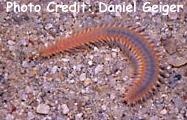
By Bob Goemans

Not Reef Tank Suitable
Not Suitable for Fish-Only Tank
Range: Worldwide
Size: 4 inches (10 cm)
Natural Environment: Inhabits sandy areas, usually under rocks on coastal platforms or dead coral on reef flats.
Aquarium Suitability: Generally, only specimens larger than a couple of inches or when being seen in large numbers are these worms problematic.
Overfeeding the aquarium is often the cause of these carnivores to multiply quickly. To reducing their numbers, there are some fish species that eat them and/or traps that can be used to reduce their numbers.
If necessary, the introduction to this Group in the Species Library has ways to trap and remove unwanted specimens.
Note: The fringes on the movement limbs, which are called setae, or cirri, are made of extremely brittle calcium carbonate spikes. If you pick up one of these worms, you will soon find out why it is called a "Fireworm". Its setae spikes can stick into your fingers and break off, causing a very painful, long-lasting sting. The setae are hollow and contain venom, which can cause you great irritation and pain.
Taxonomy:
Kingdom: Animalia
Phylum: Annelida
Class: Polychaeta
Order: Amphinomida
Family: Amphinomidae
Genus: Eurythoe
FYI: The fringes on the movement limbs, which are called setae, or cirri, are made of extremely brittle calcium carbonate spikes. If you pick up one of these worms, you will soon find out why it is called a 'Fireworm.' Its setae spikes can stick into your fingers and break off, causing a very painful, long-lasting sting. The setae are hollow and contain venom, which can cause you great irritation and pain.

.jpg)